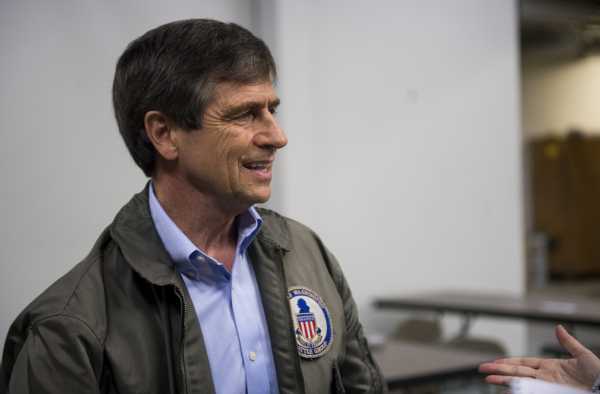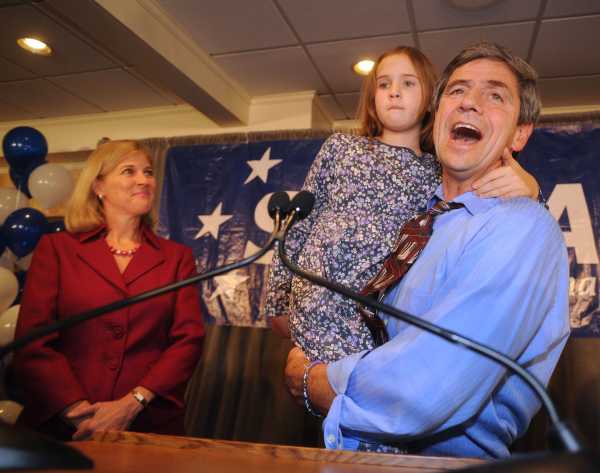
Joe Sestak, the former Congress member and three-star admiral, declared his candidacy for president in late June. He joined a crowded field of candidates that already had established frontrunners who had spent months and millions of dollars building their campaigns and courting voters.
And many policy proposals echo those of his more moderate rivals, leaving him in an uphill battle to break out. But he believes his experience as a leader in the Navy, a member of the House of Representatives, a candidate for the US Senate, and a maverick within the Democratic Party gives him the skills and perspective needed to be president of the United States.
Sestak joined the race late not because he’d spent most of early 2019 weighing whether to run but because he was caring for his daughter, who began her second fight with brain cancer in 2018. Although she’d improved following an operation late last year, a test that seemed to show the cancer returning made him put a pin in his presidential plans this spring.
“I just kept watching to make sure my daughter was in a safe harbor,” Sestak said. Only after doctors declared his daughter in remission did he jump into the race, and on the trail, he often speaks about how the experience has colored his approach to health care reform.
His general stance is fairly run-of-the-mill among the Democratic progressives; at minimum, he’s for a robust public option that he hopes most Americans would join, but he would ideally like to implement Medicare-for-all. He also has an idea inspired by his status as a veteran: creating a national health system that would employ physicians, modeled on the Veterans Health Administration.
Beyond health care, another place Sestak differs from others in the field is in his focus on foreign policy. The former admiral argues that his time at war alongside NATO allies and the understanding he gained about US adversaries while serving on the National Security Council gives him a clear-eyed vision of the challenges the US faces abroad. And his foreign policy views affect his policies broadly, from his approach to fighting climate change to farming. Even his campaign logo speaks to this focus: At its center is a globe.
Sestak has performed poorly in the polls, and he failed to make the stage at the second Democratic primary debate in July. He’ll almost certainly miss the third as well and has yet to make much progress qualifying for the fourth, either. He’s counting on a national health system and a wealth of naval experience to help him stand out amid a crowded field of largely similar and better-known moderates. Whether that’s enough remains to be seen.
Who is Joe Sestak?
Joe Sestak spent the majority of his career in the US Navy. He graduated from the US Naval Academy in 1974 and went on to serve for 31 years in both the Pacific and Atlantic fleets, as well as in Europe and the Persian Gulf. He rose steadily through the ranks, and during the wars in Iraq and Afghanistan, he led the George Washington aircraft carrier battle group — a 30-ship international coalition — into combat. By the time he retired, he had earned a PhD in political economy and government from Harvard University and was a three-star admiral.
Sestak has used his naval expertise in strategic roles as well. During the Clinton administration, he served as the director for defense policy on the National Security Council. And during the George W. Bush administration, he became the first head of Deep Blue, a Navy operations group created to fight terrorism following 9/11, before being appointed deputy chief of naval operations for warfare requirements and programs.
That final job cemented two personality traits that have come to define Sestak: his (perhaps overzealous) work ethic and his independent (some might say contrarian) spirit. It may have also ended his military career.
Then-Chief of Naval Operations Vernon E. Clark tasked Sestak with creating solutions that ran counter to conventional wisdom at the time in an effort to modernize the Navy. He did so — proposing the Navy retire 115 of its 375 ships and arguing for increasing funding for cyberwarfare initiatives.
Clark praised Sestak’s ideas, but they not always well received by others. When Clark retired, Sestak was almost immediately reassigned.
The official reason for the change was reportedly that Sestak had created a “poor command climate” — he was known for being a harsh taskmaster — but his unconventional ideas probably didn’t help either.
“I put him in that environment where he was in a position to create enemies,” Clark told the New York Times in 2010. “I should have given him better top cover.”
Sestak left the service shortly after being reassigned; he said he understood that his new superior officer wanted to bring in his own team, and that he’d planned to retire soon regardless, because at that time his daughter was beginning her first fight with brain cancer.
Once his daughter began to recover, however, Sestak planned his next move: joining the House of Representatives. With his brothers and sisters running his campaign, Sestak ran in his native Pennsylvania in 2006, beating a Republican incumbent who’d represented the district for decades with 56 percent of the vote. Sestak ran for a second term in 2008, winning with 59 percent of the vote.
During his time in Congress, Sestak was prolific in writing legislation, but few of his bills were ultimately successful. They were, however, focused on many issues central to his presidential campaign: He advocated for a public option to be included in the Affordable Care Act and was a strong critic of the Iraq War at a time when some Democrats feared speaking out against it, worried about appearing weak on national security. On his campaign site, Sestak also touts legislation he worked on to protect senior citizens, expand health care for veterans, and advance small businesses.
He was also known for being very accessible to constituents: He kept his office open seven days a week in order to field their concerns. That personal approach became a central element of his next campaign, a controversial race for Senate in 2010 that put him at odds with his party’s most powerful figures.
Sestak has a history of going against the Democratic Party
Sestak’s history of irritating leaders in his own party didn’t start with his Senate run, but it certainly came to a (rather public) head then.
Pennsylvania Sen. Arlen Specter, a Republican, decided to switch parties in 2009; that move gave Democrats a 60-vote majority in the Senate, which was instrumental in getting the Affordable Care Act passed. As thanks for his defection, then-President Barack Obama and Pennsylvania Gov. Ed Rendell promised to campaign for Specter, not only in the general election but in the primary as well.
They made good on this promise; Obama even appeared in television and radio commercials on Specter’s behalf. As Vox’s Dara Lind has explained, Specter had just one problem:
Sestak campaigned with his usual intensity; he again relied on his family for key campaign posts and focused on meeting as many voters as he could, sometimes crossing Pennsylvania four times in 24 hours. During the campaign, he described his method to the New York Times: “We would leave Philadelphia at 10 p.m., get to Pittsburgh at 3 or 4 in the morning, grab sleep for two hours, have our first meeting at 7:30 in the morning, then go all the way back to Philadelphia.”
The hard work paid off. Despite every establishment Democrat being against him — and despite briefly embroiling Obama in controversy by saying he’d been offered an administration job in exchange for dropping out — Sestak beat Specter with 54 percent of the vote. In the general election, however, he lost narrowly, falling to his Republican rival by 2 points.
Sestak had come into conflict with the Democratic establishment before; he reportedly butted heads with Rahm Emanuel during his House runs. He won those campaigns, however, and all was forgiven. But during his second try at the Senate in 2016, Sestak was not exactly welcomed back into the fold with open arms, in part because he managed to further incense his party before that race had even begun.
First, Sestak endorsed several primary challengers to Democratic incumbents in the 2012 elections. After teaching at Cheyney University, the nation’s oldest historically black college and university, following his Senate loss, he announced plans to run again. The Democratic Senatorial Campaign Committee (DSCC) recommended a campaign chair. Sestak declined, and went on to tell voters he did so because the DSCC had told him to say yes to everything their proposed chair told him to do.
The candidate also decided to reuse on his strategy from the 2010 race, except rather than driving back and forth across Pennsylvania, he walked it. National Democrats weren’t pleased. They felt his spurning of their chair and his insistence on covering the state on foot showed Sestak didn’t know what he was doing.

Sestak told voters his willingness to defy his party showed that he was an independent-minded politician with their best interests — not his party’s — at heart. The message seemed to resonate; he polled well against the Republican incumbent, far better, in fact, than the candidate the Democratic establishment decided to get behind, Katie McGinty, who had once served as the chief of staff to the governor.
Once again, every Democrat from Obama on down endorsed Sestak’s rival, and the DSCC put $1.5 million behind her. This time, Sestak couldn’t beat the establishment and lost to McGinty by about 10 points. McGinty lost to the Republican incumbent, Pat Toomey, by 1 point.
Despite this result, Sestak stands by his choice today. And he told Vox his decision remains indicative of the kind of leader he is, emphasizing that he has no problem saying, “‘No, party, you’re wrong.’ And to be able to bear the consequences of that, because as you well know, it is better to offend God than a politician, because at least God gives forgiveness.”
As was the case in the 2016 election cycle, Sestak is currently in a tough race and isn’t the favorite of any of his party’s leaders. He has been in this situation before and won, but has also been in this situation before and lost. Unlike in his previous successes, Sestak isn’t facing a current or former Republican with a long record, but Democrats who are known nationally, and whose policies are arguably highly in tune with the positions of the electorate. But Sestak believes his personality and proposals give him a strong chance of being the eventual 2020 nominee.
Joe Sestak’s key policy proposals, briefly explained
Joe Sestak shares the views of many other candidates in the 2020 primary field, and in terms of ideology he falls somewhere between the race’s most progressive candidates like Sen. Elizabeth Warren and more moderate candidates like former Vice President Joe Biden.
He supports universal pre-K and wants to make college more affordable (in part by offering what he calls “profit-free loans”) but has not called for universal loan forgiveness like Sens. Warren and Bernie Sanders have. He wants to end fossil fuel subsidies but has not gone so far as to say fossil fuel companies should be forced to pay for efforts to stop climate change, like Sen. Kirsten Gillibrand has proposed. He supports a path to citizenship for undocumented immigrants but has not endorsed the sort of substantial changes to immigration enforcement that former Housing and Urban Development Secretary Julián Castro calls for.
Overall, while Sestak has bucked party leadership on strategy and style, he rarely does so on policy. This was true during his time in Congress (he told Politico during the 2016 campaign, “When I was in the House, I didn’t usually let them know until the last day [how I was going to vote]. But then again, look at my voting record. Oh, my gosh! 100 percent voting record with AFL-CIO!”), and it remains true now.
Two places Sestak has differentiated himself from rivals, however, are health care and his ally-centric foreign policy.
1) Health care
Sestak credits federal investments in research and the care provided by the Veterans Health Administration with his daughter’s remission from cancer. So much so that he proposes making the US health care system look a lot more like the VHA — should doing so prove to be a wise idea after a four-year trial period.

Sestak believes single-payer insurance is a good idea in theory but understands not all Americans agree with him. Therefore, he has a plan to convince the public that it would be better off under a government-sponsored plan, and that maybe it would be better off receiving care from government-employed physicians.
He proposes a trial period in which Americans would have three options for receiving care:
- The first option would be to join a government-sponsored plan through which the policy holder would be able to receive care in a government-run integrated health care system modeled on the VHA; doctors in this system would be employed by the federal government, like the doctors of the VHA.
- The second option would be to enroll in a public option based on Medicare; like Medicare or Medicaid, people would see whichever private doctors accepted the insurance. Ideally, they would not have to change their doctors or care plans at all.
- The final option would be to stay on a private insurance plan.
The effectiveness of each method would be measured regularly for four years with metrics developed ahead of the trial’s launch.
“We can beat Japan and Nazi Germany in four years, but we can’t roll out a government health care website in four years? I really believe, like in the military, the executive branch should execute,” he told Vox.
At the end of the four years, Sestak would then choose either the VHA-style structure or the public option and make that the government’s official preferred method of care, eliminating the method that performed worse in the trial. He would not abolish private insurance companies, however; they would remain available to those who wanted them.
Americans would then be invited to join either the VHA-style system or the public option by age, similar to the method outlined in Sanders’s Medicare-for-all plan. Older Americans would be asked to sign up first, and over a period of four to six years, the rest of the country would be enrolled, with younger and younger people being added each year.
Again, people would not be forced to join the government-run option; Sestak believes most will choose it, however, saying, “I believe you will find, much like once you’re in the VA, once you’re in there, you don’t want out at all.”
Sestak developed this plan based on his experiences. While he praises the VHA and the care his daughter Alex received, he said the experience also contained some pitfalls — like a surprise $300,000 bill — that a public option would make impossible. But he also said he understands why someone, particularly a parent, might be reticent to try out something like Medicare-for-all during a critical time in care.
“When my daughter’s brain cancer came back last year, if anybody had tried to remove [my insurance] in two or four years, with a mandate suddenly, where my daughter had an 8 percent chance of surviving again … I would have said no,” Sestak says.
2) Foreign policy
While Sestak isn’t the only candidate who has military experience, he is the highest-ranking retired officer among the veterans. And he believes his experience fighting in recent wars and leading international coalitions — as he did during the war in Afghanistan — gives him the experience needed to lead the US and to combat adversaries abroad.
He stressed this experience in his campaign announcement video, saying, “I wore the cloth of the nation for over 31 years in peace and war, from the Vietnam and Cold War eras to Afghanistan and Iraq and the emergence of China … I grew up in this global canvas of service in the United States Navy.”
While his military experience does not seem to have made him a Mike Gravel-style pacifist, he has said he would be far more hesitant to use military force than some of his rivals (like then-Sen. Joe Biden) were in the days after 9/11. In an op-ed in the Des Moines Register, Sestak wrote: “I know that militaries can stop a problem, but they can’t fix a problem.”
He uses the line in stump speeches, but it also informs his policies, as he explained to a crowd in Iowa when discussing why the military is ill-suited to the task of removing Iran’s nuclear capabilities:
Rather than using military force against American adversaries, Sestak calls for coalition-building; he told Vox, “America’s greatest power is its power to convene, to convene the world for a common cause that serves us all.”
He has called for bringing together nations to repair the Iran nuclear deal axed by President Trump and working with Israel, Palestine, and the European Union toward a two-state solution. While he supports the Green New Deal, he stresses that the US cannot fight climate change alone and wants to work with other nations, rejoining the Paris climate accords but also expanding its framework to be more aggressive and to include more of a focus on investing in research to reverse damage that has already been done.
He also believes cooperation with allies is needed to combat the country he says is the greatest threat to the US: China.
To counter China’s growing power, Sestak proposes working with allies to put pressure on the country through existing international bodies like the World Trade Organization. He also calls for Cold War-style coordination between allied nations to develop economic incentives that could reduce China’s influence in countries it has given loans and aid. “We stopped Germany with our military. We fixed it with the Marshall Plan,” Sestak says.
Sestak is a long-shot candidate, but he’s giving the race his all
Sestak started his campaign behind his rivals. Joining late meant he didn’t have a chance at the first televised debate, and he has struggled to break through on fundraising and with name recognition. When his name is included in major polls, his support often appears nonexistent. And he did not qualify for the second primary debate in July.
But he believes his work ethic will allow him to make up for lost time. While he has said he has no plans to walk across Iowa or South Carolina, he has said he will bring his brand of retail politics to early primary states, focusing on forging personal connections.
He’s set up camp in Des Moines, Iowa, having not left the state since he announced his candidacy and, according to the Iowa Starting Line, has built a supportive community around the Econo Lodge where he and his team live. The owner of the hotel has reportedly promised to bring Sestak to his temple; he’s made friends with the construction workers who are repairing the building (they hand out flyers for him). And he’s hired local homeless veterans as campaign workers.
Sestak is aware of the challenges he faces; he told Vox he’s seen an internal email from a media company nixing the idea of giving him a town hall. He knows some top Democrats may still hold his Senate races against him. But he believes his story and message can and will resonate with voters.
He’s an anti-establishment Democrat who has beaten a Republican in a Republican district, he’s someone with military and foreign policy experience, and he has a deeply personal reason for his approach to health care reform: This is his record and he’s running on it.
“What this nation most yearns for and most wants is someone who is accountable to them. Not to party. Not to ideology. Not to self. Not to any special interests,” he told Vox. “That’s what America needs, someone who people actually believe — as they did in my district — is willing to be accountable to them.”
Whether voters in the Democratic primary agree remains to be seen.
Sourse: vox.com






